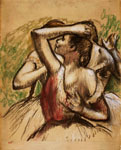|
Pastel painting is enjoying a renaissance in
artistic and public popularity after a long period of neglect. Once
relegated as a drawing medium of little consequence, today, works in
pastel command some of the highest prices for contemporary art. Considered
one of the purest of painting mediums, pastel is as colorful and vigorous
as any method of painting.
PASTELS ARE NOT
CHALK! They are pure pigment, the same used in making all fine art paints.
It is the most permanent of all mediums when applied to conservation
grounds and properly framed. Pastel has no liquid
binder that may fade,
yellow, crack or blister with time or exposure to light, as with other
mediums. The name pastel comes from the French word pastische, meaning
pure powdered pigment ground into a paste with a small amount of gum
binder. The paste is rolled and dried in stick form with an infinite
variety and value range of colors. Pastels from the 16th Century exist
today, as fresh and alive as the day they were painted!
Pastel artworks are created by stroking
sticks of dry pigment across an abrasive ground designed for pastel,
imbedding color in the "tooth" of the ground. If the ground is completely covered with pigment in a painterly fashion,
the work is considered a pastel painting; leaving much of the ground
exposed produces a pastel drawing. Techniques vary with individual
artists. Pastel can be blended or used with visible strokes. The medium is
favored by many artists because it allows a spontaneous approach. There is
no drying time and no mixing of colors is needed.
Pastel can be traced back to the 16th
Century. Its invention is attributed to the German painter Johann Thiele.
A Venetian woman artist, Rosalba Carriera, was the first to make
consistent use of Pastel. Chardin did portraits with an open stroke, while
LaTour preferred the blended finish. A galaxy of famous artists followed .
. . Watteau, Copley, Delacrox, Millet, Manet, Renoir, Degas, Toulouse-Lautrec,
Vuillard, Bonnard, Glackers, Whistler, Hassam, William Merrit Chase . . .
and more recently, well known artists such as Daniel Greene, Sally Strand,
Albert Handell, Jane Lund, Doug Dawson, Dianah Randolph, Deberah Deichler
and Richard Pionck, to name just a few, have employed pastel with
marvelous results.
Edgar Degas was the most prolific user
of Pastel, and its champion. His protégé, Mary Cassatt, introduced the
impressionists, and Pastel, to her friends in Philadelphia and Washington,
and thus to the United States. In the spring of 1983, Sotheby Parke Bernet
sold at auction two Degas Pastels for more than $3,000,000 each! Both
Pastels were painted about 1880. To the right is "Three Ballet
Dancers" by Degas. protégé, Mary Cassatt, introduced the
impressionists, and Pastel, to her friends in Philadelphia and Washington,
and thus to the United States. In the spring of 1983, Sotheby Parke Bernet
sold at auction two Degas Pastels for more than $3,000,000 each! Both
Pastels were painted about 1880. To the right is "Three Ballet
Dancers" by Degas.
The Pastel Society of America
(PSA) was
founded in New York in 1972 to promote and independently display pastel
works of art as a unique and serious art medium. In response to the
growing public and artistic popularity of pastel, many local pastel
societies have since been formed throughout the country, including the
Northwest Pastel Society (NPS) in Seattle, Washington, and the Pastel
Society of the West Coast (PSWC), Roseville, California.
|
